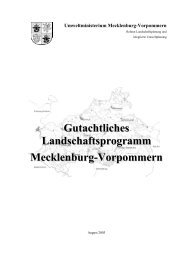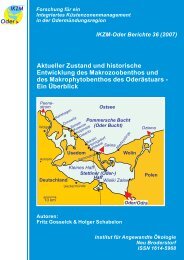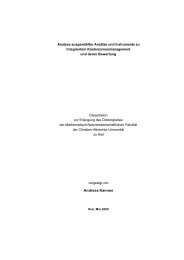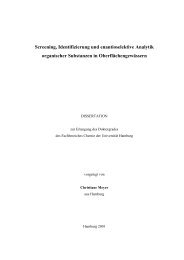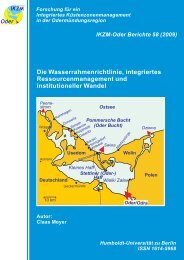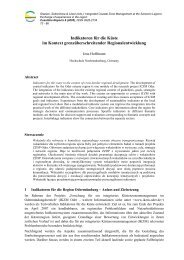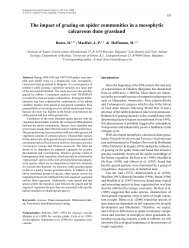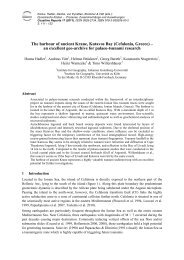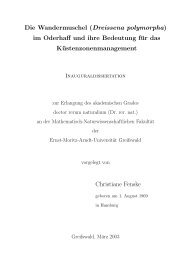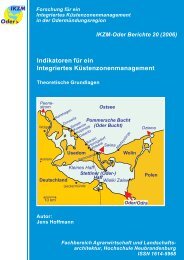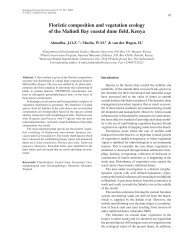Create successful ePaper yourself
Turn your PDF publications into a flip-book with our unique Google optimized e-Paper software.
49<br />
<strong>EUROSION</strong> <strong>Case</strong> <strong>Study</strong><br />
EBRO DELTA<br />
(SPAIN)<br />
Contact:<br />
Inmaculada RODRÍGUEZ SANTALLA<br />
Universidad Rey Juan Carlos<br />
Escuela Superior de Ciencias<br />
Experimentales y Tecnología<br />
C/ Tulipán, s/n 28933 Móstoles<br />
Madrid (<strong>Spain</strong>)<br />
Tel: +34 91 488 70 17<br />
Fax: +34 91 488 74 90<br />
e-mail: i.rodriguez@escet.urjc.es<br />
1
<strong>EUROSION</strong> <strong>Case</strong> <strong>Study</strong><br />
1. GENERAL DESCRIPTION OF THE AREA<br />
The delta of the River <strong>Ebro</strong> (see Figure 1) is on the north-eastern coast of <strong>Spain</strong>, in the<br />
province of Tarragona, in the Autonomous Community of Catalonia. It is the main coastal<br />
delta on the Iberian peninsula and one of the largest in the Mediterranean.<br />
1.1. Physical process level<br />
1.1.1 Classification<br />
General: delta plain, long strands with dune fields<br />
CORINE: beaches<br />
Coastal guide: delta, dunes<br />
The <strong>Ebro</strong> delta was once considered a micro-tidal delta dominated by the river regime and<br />
wave action (Galloway, 1975). Owing to the loss in intensity of the influence of the River<br />
<strong>Ebro</strong>, the role of the waves has increased and its development and morphology are now<br />
dominated largely by wave action.<br />
1.1.2 Geology<br />
The Holocene delta of the River <strong>Ebro</strong> has a coastal length of approximately 50km. It is<br />
basically a plain, not exceeding a height of 4 or 5m above sea level, with an emerged<br />
surface extending over approximately 325km 2 (Rodríguez, 1999), while the submerged<br />
surface (prodelta) extends over approximately 2,172km 2 (Serra, 1997). Geological mapping<br />
of the delta shows that the delta plain is occupied by quaternary Holocene sediments,<br />
deposited on a gravel base, largely made up of coarse and medium sand, muddy clays and<br />
mud, and with an upper layer of medium and fine sand. Together it forms crevasse, natural<br />
levee, dune and marsh structures (ITGE, 1996). The subsidence of the area is estimated at<br />
0.20cm/yr (ITGE, 1996).<br />
2
<strong>EUROSION</strong> <strong>Case</strong> <strong>Study</strong><br />
Fig. 1: Location map of the <strong>Ebro</strong> <strong>Delta</strong> (satellite image).<br />
The average grain size of the sediment on the shoreline is around 250µm, showing variations<br />
along the coast depending on the energy of the incident swell and, therefore, the intensity of<br />
sediment transport. This sandy shore extends to a depth of 12-15m, below which very fine<br />
sediments appear around almost all the coastline (Sánchez-Arcilla et al., 1997).<br />
3
<strong>EUROSION</strong> <strong>Case</strong> <strong>Study</strong><br />
Historical development of the <strong>Ebro</strong> delta<br />
In Roman times, the coast went in as far as Tortosa and in the 12 th century it was situated<br />
near Amposta. In the 15 th century, it extended over 130km 2 and towards the beginning of<br />
the 16 th century this coastal area behaved like an estuary and the shoreline was situated<br />
approximately at the level of Amposta. Between the beginning of the 16 th century and the<br />
middle of the 17 th century there was great deforestation caused by the need for ships<br />
following the discovery of America, which caused an expansion of the delta, as it facilitated<br />
erosion, generating a great progression of sediments (a figure of some 10m a year). In<br />
general, the increase in deposits in the area depended on the general coverage and on the<br />
prevailing climate in the area (Maldonado, 1972, 1986).<br />
The historic mouth of the River <strong>Ebro</strong> is situated on the eastern side of the pro-delta, but it<br />
changed because of a great flood which happened in October 1937, moving it to the north<br />
and beginning the opening of the current “Gola Nord” (Northern Mouth). By the end of the<br />
50s, only this one was active and this situation continues until today. As well as this<br />
phenomenon, the construction of the Mequinenza and Ribarroja dams in the 60s conditioned<br />
the current development of the delta front, which suffers continuous erosion without<br />
compensation from river deposits.<br />
2000 B.C.<br />
1700 A.D. approx.<br />
C. 6 th -10 th A.D.<br />
1749 A.D.<br />
1580 A.D.<br />
1923 A.D.<br />
Fig. 2: Historical evolution of the <strong>Ebro</strong> <strong>Delta</strong> shoreline (Source: <strong>Ebro</strong><br />
<strong>Delta</strong> Natural Park - drawn by A. Canicio).<br />
1.1.3 Morphology of the coast<br />
The coastal morphology of the <strong>Ebro</strong> <strong>Delta</strong> (Figure 1) is made up of a delta front, in which the<br />
current mouth of the River <strong>Ebro</strong> is situated, and two spits that partially close two adjacent<br />
lagoons: El Fangar, situated to the NW and Los Alfaques, to the SW. The second spit is<br />
joined to the rest of the delta by the Trabucador bar, which is approximately 250m wide and<br />
6km long. The mouth shows a very flat profile with a low slope, which encourages the<br />
development of bars. The current appearance of the <strong>Ebro</strong> delta is the result of various<br />
processes acting directly on it (see Figures 3a & 3b).<br />
4
<strong>EUROSION</strong> <strong>Case</strong> <strong>Study</strong><br />
Firstly, the retention of solids by dams positioned along the course of the river and the<br />
increase in water consumption, basically for irrigation, and, secondly, the marine processes,<br />
which continuously reshape the delta and alter its configuration.<br />
Fig. 3a: Last stretch of the River <strong>Ebro</strong>.<br />
River network<br />
Fig. 3b: Actual mouth of the River <strong>Ebro</strong>.<br />
The last 28km of the River <strong>Ebro</strong> run through the delta plain, showing notably different<br />
characteristics to the ones it has upstream, where it has been considerably altered during<br />
the second half of the 20 th century. These changes are largely due to the construction and<br />
use of numerous dams throughout its basin, particularly those at Mequinenza and Ribarroja<br />
(Dolz et al., 1997) on the lower course of the River <strong>Ebro</strong>.<br />
The River <strong>Ebro</strong> basin is 97% regulated (Varela et al., 1986) and it is estimated that<br />
nowadays it discharges less than 1% of what the river used to discharge at the beginning of<br />
the 20 th century. If to this is added the effect of the dams and the fall in precipitation in the<br />
<strong>Ebro</strong>’s drainage basin, as well as diversions of the course for irrigation, the result is a<br />
considerable decrease in the transport of sediments. Consequently, certain sections of the<br />
delta are receding (Rodríguez, 1999).<br />
Secondly, the reduction in flow encourages the intrusion of a wedge of salt water that<br />
penetrates the river underneath the fresh water. This salt wedge alters the capacity to<br />
transport solids and reduces the depth of the layer of fresh water, making it more difficult<br />
for the delta’s agricultural operations to use it.<br />
Navigation on the river, present in these waters since ancient times, has now been<br />
discovered as an interesting tourists attraction (Dolz et al., 1997).<br />
5
1.1.4 Physical processes<br />
<strong>EUROSION</strong> <strong>Case</strong> <strong>Study</strong><br />
Maritime climate and coastal dynamics<br />
The environment is micro-tidal, with an astronomical tidal range of 25cm. It is worth<br />
pointing out the presence of meteorological tides, especially in the months from September<br />
to November, when they reach their greatest magnitude. The average annual significant<br />
wave height in deep water in the area is around 0.7m, with an average period of the order<br />
of 4s (Sánchez-Arcilla et al., 1997).<br />
The directions of origin of the swell are: north, acting on the northern hemi-delta; south<br />
acting on the southern hemi-delta; east acting on the entire delta. The latter produces the<br />
most significant transport of sediments, as it shows the largest waves with most energy<br />
generating movement towards the north in the northern hemi-delta and towards the south<br />
in the southern hemi-delta.<br />
1.1.5 Erosion<br />
In general, erosion and progradation areas alternate on the <strong>Ebro</strong> delta coast. The<br />
longitudinal transport system along the coast is responsible for the distinctive configuration,<br />
with sedimentation and erosion effects. Currently, the developmental tendency of the delta<br />
is regressive, with variations of greater or lesser degree depending on the stretch. This is<br />
because wave action is eroding the beaches as it reaches the coast without replacement of<br />
the sediment removed.<br />
On a large scale, the delta can be considered as forming a closed system where the rates of<br />
erosion and progradation cancel each other out. According to Rodríguez (1999), between<br />
1957 and 1998 there was a slight increase in the delta surface of about 500ha (5km 2 out of<br />
the 320km 2 of emerged surface currently recognised, approximately 1.5% of the total delta<br />
area), which may be considered as a redistribution of sediments following the patterns<br />
marked out by the system of currents in the area, together with the possible contribution of<br />
sediments by the river. The longitudinal transport system along the coast is responsible for<br />
the distinctive configuration with sedimentation and erosion effects, as explained in earlier<br />
sections.<br />
There are various factors with a direct impact on the erosion process in the <strong>Ebro</strong> delta.<br />
Firstly, the reduction in river flow and therefore in the sediments that arrive at the mouth<br />
due, on one hand, to the regulation of the river by means of dams and, on the other, to the<br />
diversion of the water for irrigation and water supplies. This reduction in flow also causes the<br />
salt water wedge to penetrate further and further, affecting the river’s power to transport<br />
solids. Secondly, the regulation of the river also weakens the flood regime, preventing the<br />
contribution of sediments to the delta plain compensating for the subsidence of the delta and<br />
the rise in sea level.<br />
Recently the Spanish government has approved the National Hydrological Plan (Act 10/2001,<br />
5 July) which includes various measure, among them, the transfer of water between river<br />
basins with the aim of mitigating shortages in various Spanish provinces. In the case of the<br />
<strong>Ebro</strong>, the transfer of 1,050hm 3 /year is proposed to different areas, together with the<br />
building of new dams in the <strong>Ebro</strong> basin. The NHP has an estimated cost of 23,500 million<br />
euros and is the subject of much criticism and civil protest, because these plans are seen as<br />
a new threat to the <strong>Ebro</strong> delta ecosystem.<br />
6
<strong>EUROSION</strong> <strong>Case</strong> <strong>Study</strong><br />
1.2. Socio-economic aspects<br />
1.2.1 Population rate<br />
Human occupation of the delta began quite late and was closely linked to the transformation<br />
of the wetland into rice fields aided by the construction of irrigation channels. Since 1860,<br />
there has been a rapid increase in population, which seems to have stopped in the 1990s.<br />
However, it can still be said that the <strong>Delta</strong> continues to be, in terms of population, one of the<br />
most dynamic areas in southern Catalonia.<br />
Although the total population of the seven municipalities forming part of the delta was, in<br />
1995, about 46,800 inhabitants, the population living in the delta itself is only about 15,000,<br />
basically concentrated in the municipalities of Deltebre and San Jaume, characterised by its<br />
great extension and dispersal. The density is about 120 inhab/km 2 , similar to the Catalan<br />
average and the highest in the so-called “Terres de l’Ebre” (Lands of the <strong>Ebro</strong>) (Environment<br />
Ministry, 2001).<br />
1.2.2 Major functions of the coastal zone<br />
Fisheries and aquaculture: Fishing is a fundamental activity and it involves the<br />
ports of Sant Carles de la Rapita and L’Ampolla within the delta and the nearby<br />
parts of Les <strong>Case</strong>s d’Alcanar and L’Ametlla. It provides approximately 15% of<br />
Catalonia’s annual production, with jobs for around 2,000 people. However, fishing<br />
in the coastal lagoons has recently reduced because of over-exploitation and the<br />
degradation of the lagoons.<br />
Agriculture: Agriculture is one of the great economic bases, with the clear<br />
predominance of rice - of the 24,554 hectares under cultivation, 15,215 hectares<br />
correspond to this crop, which represents 98% of the total production of this cereal<br />
in Catalonia. It is followed by vegetables and fruit trees. Agricultural co-operatives,<br />
especially the organisations of rice-growers, are very important. In spite of the fact<br />
that the agricultural transformation has involved a considerable reduction in the<br />
natural surface of the delta plain, the rice fields have an important ecological<br />
component. They provide a large area of water during a large part of the year,<br />
creating a great source of food for birds that temporarily or permanently populate<br />
part of the delta. Livestock farming has been reduced to a small scale activity faced<br />
with the great weight of agriculture.<br />
Industry: little developed, with only that based on agriculture and salt extraction<br />
(Trinidad salt pans in Los Alfaques) worth mentioning.<br />
Hunting: this is another firmly rooted activity in the delta, which is now a leisure<br />
activity with deep sociological roots. This activity also brings financial income for<br />
the local population to supplement the agricultural activity, as private reserves<br />
charge for shooting rights. Hunting has been structured in zones and organised in<br />
different legal forms involving guaranteed conservation of the delta’s birds, and<br />
sustainable hunting practices.<br />
Tourism and recreation: this is a relatively recent activity in the delta, as<br />
previous attempts to develop this sector failed because of the lack of infrastructure<br />
and services, the presence of insects and various other factors. That changed in the<br />
1980s, with the declaration of the <strong>Ebro</strong> <strong>Delta</strong> Natural Park, which involved publicity<br />
about the area’s natural, landscape and traditional values. The result has been a<br />
tourist offer based on the eco-tourism model that presents the <strong>Delta</strong> as an<br />
exceptional site.<br />
7
<strong>EUROSION</strong> <strong>Case</strong> <strong>Study</strong><br />
Ports and ships: there are two ports within the delta (Sant Carles de la Ràpita<br />
and l’Ampolla) and two ports nearby (Les <strong>Case</strong>s d’Alcanar and l’Ametlla). The main<br />
use of these ports is as fishing ports and recreational marinas.<br />
1.2.3 Land use<br />
The <strong>Ebro</strong> delta has isolated beaches with golden sands and peaceful bathing conditions with<br />
moderate waves. However, the degree of occupation of these beaches is average to low<br />
because their accessibility is limited, with a vehicle needed in order to reach them. In<br />
addition, most of them lack beach services (showers, bins, toilets, signs, parking etc.).<br />
Riumar beach is the only beach of a semi-urban nature. It has a promenade, parking and all<br />
beach services.<br />
The delta plain is occupied largely by rice fields. As well as rice, there are other irrigated<br />
crops, which are basically on plots near to the course of the river, and citrus fruit plantations<br />
in the interior of the island of Gracia. The occupation of all the Los Alfaques spit by the<br />
Trinidad salt pans is worth mentioning.<br />
1.2.4 Assessment of capital at risk<br />
Information is unavailable<br />
Fig. 4: Development of visitors to the <strong>Ebro</strong> <strong>Delta</strong> 1992-2001 (Source:<br />
Natural Park Report nº 19).<br />
8
2. PROBLEM DESCRIPTION<br />
2.1. Eroding sites<br />
<strong>EUROSION</strong> <strong>Case</strong> <strong>Study</strong><br />
The morphological configuration of the <strong>Ebro</strong> <strong>Delta</strong> leads to the existence of areas that<br />
behave differently in terms of coastal dynamics. There are beaches with a marked erosional<br />
nature and beaches whose tendency is accretion. The longitudinal transport system along<br />
the coast is responsible for the distinctive configuration, with sedimentation and erosion<br />
effects.<br />
Northern Hemi-delta<br />
This is made up almost completely of sand, which forms the beaches and dunes that run<br />
along the coastal fringe of the Fangar spit and the beaches of La Marquesa and Pal (see<br />
aerial view in Figure 5).<br />
Fangar spit<br />
The Fangar spit extends south-east from the Fangar lighthouse with an area which oscillates<br />
between 180,000m 2 and 225,000m 2 . Its length various between 1,800 and 2,000m and it is<br />
between 175 and 350m wide depending on the prevailing climatology. It has a landscape of<br />
dunes practically all along the outside of the spit (Figure 6), which represents the most<br />
extensive formation in the whole delta and which currently is the only functioning dune area.<br />
At times of meteorological tide, the dunes are wiped out by wave action, depositing the sand<br />
inside the Port of Fangar. They are later being formed again by wind processes.<br />
Estany del Canal Vell<br />
o Balsa de L'Estella<br />
Pal Beach<br />
Goleró Beach<br />
Natural Port of<br />
Fangar<br />
Marquesa Beach<br />
Arenal Beach<br />
Peninsula of Fangar<br />
Fangar Beach<br />
Fig. 5: Northern Hemi-delta (Source: Aeroguía del litoral - geoplaneta.com).<br />
9
<strong>EUROSION</strong> <strong>Case</strong> <strong>Study</strong><br />
Fig. 6: Dune field – Fangar Sand Spit (August 2002).<br />
In studies carried out in the area (University of Barcelona, 1997) the importance of wind<br />
transport was noted when making an overall evaluation of the marine dynamics, with<br />
average wind transport potential quantified at an average of 40m 3 /m/yr and occasionally<br />
greater during extreme events. Considering that the width of the current dune area is<br />
250m, wind transport contributes to the sedimentary dynamic of the whole coast of the<br />
northern hemi-delta with a volume of 10,000m 3 /yr towards the SE.<br />
In a recent study of the development of the spit between 1957 and 2000, commissioned by<br />
the Environment Ministry (2001), it is estimated that the growth of the point of the spit over<br />
these 43 years has been 1,280m and the rate of growth in the last decade has been 33m/yr.<br />
The increase in surface area is measured at somewhat more than 180ha, which means an<br />
increase of more than 4 hectares per year (Figure 7). In the same study, the speed of<br />
growth of El Goleró beach, just opposite the point of the sand spit was estimated, obtaining<br />
a result of 2m/yr. These figures allow for an estimated possible closure of the bay, if the<br />
hydrodynamic conditions governing the system allow it, in about 35 years.<br />
10
La Marquesa and Pal beaches<br />
<strong>EUROSION</strong> <strong>Case</strong> <strong>Study</strong><br />
The dune cordon continues towards the SE from the Fangar bar along La Marquesa beach<br />
until Gola de Pal, interrupted by various structures (a road, a breakwater and a restaurant).<br />
Plans haven been made that involve eliminating these barriers and regenerating the dune<br />
system,which is currently in a very poor state. This is largely due to the human activity,<br />
involving the indiscriminate entry and parking of vehicles among the dunes. La Marquesa<br />
and Pal beaches show considerable regression in the coastline (Figure 7), which has been<br />
quantified at 200m and 245m respectively in the last 40 years, with a reduction in their area<br />
of 116 hectares, which is equivalent to almost 3ha/yr (Environment Ministry, 2001).<br />
River mouth<br />
Fig. 7: Variation in the coastline of the Northern Hemi-delta (Env. Minist. 2001)<br />
At the river mouth the processes of progradation and regression of the delta front happen<br />
much faster than on the rest of the delta coast due to higher wave energy in this area (see<br />
aerial view in Figure 8).<br />
11
Eucalitus Beach<br />
Serrallo beach<br />
Mitjorn Beach<br />
<strong>EUROSION</strong> <strong>Case</strong> <strong>Study</strong><br />
Buda Island<br />
<strong>Ebro</strong> River<br />
Tortosa Cape<br />
Riomar beach<br />
San Antonio Island<br />
Fig. 8: Mouth of the River <strong>Ebro</strong> (Source: Aeroguía del litoral - geoplaneta.com).<br />
In terms of physical geography, the outstanding feature is the growth of spit at the point of<br />
the mouth (San Antonio spit), which is progressively moving towards the west because of<br />
the predominant direction of the currents in this part of the delta. Due to storms the spit can<br />
disappear, being formed again afterwards (Jiménez et al, 1995).<br />
Cape Tortosa is the area that has suffered most erosion in recent years because it is the<br />
area of the delta that absorbs most wave energy (Serra, 1997). It is estimated that the<br />
linear regression has been close to 1,600m in 40 years (Figure 9), which corresponds to a<br />
velocity of 39m/yr (Rodríguez, 1996, 1999). The maximum was reached between the 1950s<br />
and 1970s, gradually diminishing in subsequent periods. In the period 1994-1998 regression<br />
was close to zero , giving rise to the idea that the delta is reaching a more stable<br />
configuration (Rodríguez, 1996, 1999).<br />
As a result of these erosion processes, there has been an accumulation of sand in the form<br />
of spits, configuring the current morphology of the river mouth.<br />
12
Southern Hemi-delta<br />
<strong>EUROSION</strong> <strong>Case</strong> <strong>Study</strong><br />
The southern hemi-delta, situated on the south side of the river mouth, is favoured by net<br />
sedimentation as a result of coastal transport processes (see aerial view in Figure 10).<br />
Los Eucaliptus beach<br />
Fig. 9: Shoreline retreatment of the river mouth (Rodríguez, 1999).<br />
The developmental tendency of this beach is slightly towards progradation, showing an<br />
advance in the coastline of approximately 300m from 1957 to 1998 (Rodríguez, 1999). See<br />
Figure 11.<br />
13
Sant Carles de la<br />
Rápita<br />
Trabucador spit<br />
<strong>EUROSION</strong> <strong>Case</strong> <strong>Study</strong><br />
The Trabucador Bar is a narrow, sandy, rectangular formation about 250m wide and 6km<br />
long. It was formed due to the mutual annexation of sand bars with material from the<br />
erosion of the delta front, transported by the effects of longshore drift. At certain times and<br />
under heavy storm conditions the bar is overwashed (at times it has even been broken)<br />
introducing sediments inside the bay, which causes the spit to migrate towards the coast.<br />
Rodríguez (1999) estimates that the bar has turned almost 3º towards land and its width<br />
has slightly reduced to an average of approximately 60m.<br />
Los Alfaques spit<br />
Natural Port of<br />
Els Alfaqs<br />
Trabucador Bar<br />
Fig. 10: Southern Hemi-delta (Source: Aeroguía del litoral – geoplaneta.com).<br />
The Los Alfaques spit is formed by strips of sand that have annexed each other, forming the<br />
present shape of the bar. It is worth pointing out the presence of beach ridges which mark<br />
the different positions the coast has taken up. Together with the Fangar spit, it is one of the<br />
main areas for the deposition of eroded material anywhere in the delta. The area has<br />
increased by 200ha between 1957 and 1998 (Rodríguez 1999).<br />
14
<strong>EUROSION</strong> <strong>Case</strong> <strong>Study</strong><br />
Fig. 11: Development of the coastline of the southern hemi-delta (Rodríguez, 1999)<br />
2.2. Impacts<br />
The <strong>Ebro</strong> delta is highly vulnerable to erosion because it is a very low-lying area (∼ 4m<br />
above sea level) and therefore it is very sensitive to the agents causing erosion. Also erosion<br />
causes the loss of value (economic, social, natural etc…), although this may be difficult to<br />
quantify (Sánchez-Arcilla, 1997).<br />
In the long term the amount of sediment in the delta can be considered to be stable.<br />
Redistribution of the sediment causes progradation of the coast at certain parts and<br />
regression at others (almost all of the external coast of the northern hemi-delta, Cape<br />
Tortosa and Trabucador Bar). These are generally the most important areas used for man<br />
and/or the biological system, so their erosion raises significant problems.<br />
15
3. SOLUTIONS / MEASURES<br />
3.1. Policy options<br />
<strong>EUROSION</strong> <strong>Case</strong> <strong>Study</strong><br />
Do nothing, Hold the line, Managed realignment.<br />
3.2. Strategy<br />
The delta system as a whole is part of environmental surroundings to which plants, animals<br />
and man contribute. Any engineering action has to be integrated in the dynamic balance.<br />
This action should tend to rebalance the shape of the coast without damaging the system.<br />
Measures to control erosion must be achieved using techniques which do not have a<br />
negative impact on the rest of the delta’s physical and ecological system (Montoya and<br />
Galofré, 1997).<br />
Action on the delta coast has been marked by the presence of the protective form of the<br />
<strong>Ebro</strong> <strong>Delta</strong> Natural Park, since it was set up by the Catalan government (Decree 357/1983, 4<br />
August, ratified and expanded by Decree 332/1986, 23 October). So, coastal engineering<br />
options have been basically directed at preserving and recovering the environment,<br />
attempting to mitigate and/or minimise the impact of hard engineering measures.<br />
3.3. Technical measures<br />
3.3.1 History, type and technical details<br />
As has already been mentioned, action carried out in the <strong>Ebro</strong> delta environment has always<br />
been directed at recovering the natural environment, with attempts made to minimise the<br />
impact involved in any coastal engineering action. However, some schemes have been<br />
drawn up proposing the rigid fixing and total defence of the delta to prevent the regression<br />
of the coastline (Iberinsa, 1992).<br />
Other measures have been directed at protecting the <strong>Ebro</strong> delta against the rising sea level<br />
and overwashing without taking erosion processes into account. These measures were taken<br />
as a consequence of the breaking of Trabucador Bar in October 1990 because of a storm.<br />
The volume eroded was about 70,000m 3 and represents practically 85% of the whole bar<br />
(Sánchez-Arcilla et al., 1997). In January 1991 this event led to the beginning of emergency<br />
works, building 1km of dune 1.5m high, 12m wide at the crown and 24m at the base, fixing<br />
it using cane stakes and dune vegetation (Amophila Arenaria, Othanthus Marítima and<br />
Elymus Factus). This action was completed in 1992 with the “Trabucador Bar Protection<br />
Scheme” (see Figure 12) which consisted of extending the above solution along the whole<br />
bar, positioning the dune in the interior, beside the bay, with the aim of preventing<br />
overwashing by water from the open sea when high waves were produced. The fixing<br />
system consisted on the one hand of constructing 10 x 10m stake “corrals” of spartina<br />
versicolor, and on the other hand of planting dune vegetation (Montoya et al., 1997).<br />
16
<strong>EUROSION</strong> <strong>Case</strong> <strong>Study</strong><br />
Fig. 12: Typical profile of the dune scheme constructed on Trabucador bar<br />
(Montoya et al., 1997).<br />
In the area of the <strong>Ebro</strong> delta, actions have also been carried out to protect the banks of the<br />
River <strong>Ebro</strong> (Protection of the River <strong>Ebro</strong> in the “Mares de Deu” area, 2000) and at its mouth<br />
(Protection of the left bank of the River <strong>Ebro</strong> at its mouth, 1998).<br />
Other types of action are aimed at providing accesses and services to the beaches, thereby<br />
ensuring their use. In this respect the following works are worth mentioning: “Accesses and<br />
service areas on Trabucador beach” (1993); “Path and service area next to the River<br />
Mitjorn” (1994); “Stabilisation of dunes and facilities on Riumar beach” (1997); “Accesses<br />
and service areas on the beaches at San Jaume d’Enveja” (1997); Organisation and<br />
improvement of Arenal beach, L’Ampolla, (1997).<br />
In addition, the General Directorate for Coasts at the Environment Ministry, has the following<br />
schemes at the official project stage:<br />
Scheme for environmental conditioning and land organisation on Los Eucaliptus<br />
beach (2001).<br />
Scheme for environmental action around the Fangar Peninsula, La Marquesa beach<br />
and Pal beach (2001).<br />
Scheme for environmental action on the seafront at Sant Jaume d’Enveja, overall<br />
treatment of the area with the inclusion of protection for sites of environmental<br />
interest in Platjola lagoon and La Alfacada lagoon (2002).<br />
River path opposite the urban centre of Deltebre.<br />
Improvement action at Les Olles lagoon and the embankment at Sant Pere.<br />
17
<strong>EUROSION</strong> <strong>Case</strong> <strong>Study</strong><br />
The various actions and objectives shown by the schemes mentioned above are summarised<br />
below:<br />
Construction of walkways on the dunes to prevent deterioration and preserve the<br />
natural defence they provide against erosion (example: Riumar, Pal, Marquesa and<br />
Fangar beaches).<br />
Regeneration of dunes, fixed with the help of stakes and dune vegetation<br />
(example: Trabucador Bar).<br />
Removal of infrastructure located on the shore that prevents the normal<br />
development of the coastal dynamic (example: La Marquesa and Pal beaches).<br />
Organisation of uses in the coastal area which involve actions ranging from the<br />
building of car parks, preventing the dunes being used for this purpose (example:<br />
Marquesa and Fangar beaches), to the compulsory purchase of agricultural land<br />
(rice fields) located on the edge of the beach (Pal beach) and limiting wheeled<br />
vehicle traffic in the dunes (example: Fangar bar) and the creation of new<br />
alternative beach accesses and the conservation of nesting areas by staking them<br />
off.<br />
Putting up signs near areas of landscape, environmental and cultural interest.<br />
Respect for the cultural values of the area (examples: throughout the delta).<br />
Construction of landscape viewpoints that allow the contemplation, study and<br />
control of the protected environment (examples: Fangar, Riumar, mouth of the<br />
Mitjorn, La Marquesa beach, La Alfacada lagoon, Los Eucaliptus beach – the last<br />
three at the plan stage).<br />
Experimenting with a new method of coastal defence called the Beach Drainage<br />
System which encourages the deposition of sand on the beach by installing<br />
drainage and a pumping system (example: Riumar beach).<br />
3.3.2 Costs<br />
Figure 13 (next page) shows all the works carried out in the <strong>Ebro</strong> delta and the forthcoming<br />
actions planned, as well as the budget for carrying them out.<br />
18
<strong>EUROSION</strong> <strong>Case</strong> <strong>Study</strong><br />
Fig. 13: Map of the position of works carried out and planned works (Environment Ministry, 2002)<br />
19
<strong>EUROSION</strong> <strong>Case</strong> <strong>Study</strong><br />
4. EFFECTS AND LESSONS LEARNT<br />
4.1. Effects related to erosion<br />
The evaluation of the effects of interventions on the delta system can only be attempted in<br />
the medium and long term because they have been aimed at protecting and maintaining the<br />
beach, the dune ecosystems and the recovery of natural environments, like the lagoons and<br />
banks of the River <strong>Ebro</strong>. However, the interventions carried out have enabled the elimination<br />
of man-made barriers impeding the natural development of the delta system; reducing and<br />
regulating activities and uses causing its degradation and stimulating natural processes<br />
supporting its recovering. The interventions planned in the area have been characterised by<br />
minimising building activity within it, being directed towards regulatory intervention policies<br />
that basically cover the organisation of the land, affecting land use and the exploitation of<br />
the existing natural resources. Direct effects on the delta ecosystems can be quantified from<br />
the censuses of species colonising it and also from the growth of the surface area of the<br />
delta affected by protective regulations. This is included as an area that can be colonised by<br />
natural species living there and using the delta seasonally for reproduction or as a transit<br />
area on migration.<br />
4.2. Effects related to socio-economic aspects<br />
The actions carried out in most cases impose restrictions on land use and the exploitation of<br />
its natural resources. In principle, these actions could be judged as negative for the social<br />
and economic development of the area. However, it must be taken into account that the<br />
expected impacts refer to indicators supporting the concept of Sustainable Development,<br />
which is rational use compatible with the environment and the natural resources, preserving<br />
their exploitation and benefits for future generations. Although the design of the schemes<br />
aims at the reduction, in many cases, of agricultural, fishing and hunting activity; overall it<br />
has not had a worrying impact on these sectors. In addition, it has made and is making<br />
possible the development of other activities belonging to the service sector, with a much<br />
greater socio-economic development potential, producing not merely a compensatory effect,<br />
but also growth.<br />
In this way, the design of actions has been aimed at harmonising their impacts with the<br />
development of capacity in the tourist sector, connected to the ecological, landscape,<br />
environmental, cultural and educational values of the environment, which have been<br />
incorporated as strategic objectives of the actions. The visitor statistics for the area,<br />
together with schemes to develop hotel, restaurant and eco-museum facilities, walking and<br />
cycle touring activities, special gastronomic and educational events, management of beach<br />
access, identification of swimming areas, viewpoints etc. among others, are the most<br />
important indicators in this respect.<br />
• Gaps in information<br />
In ecosystems as fragile as those of the delta, actions must be directed towards integrating<br />
natural and human aspects, using sustainable development criteria which enable the<br />
different uses the delta currently has (fishing, agriculture, salt extraction, bathing) to be<br />
made compatible with the natural environments and unique biodiversity ecosystems (plant<br />
and animal communities). To do this, it is necessary to have a land organisation tool that<br />
enables forecasting of the future impact of any action on the rest of the delta and the areas<br />
most sensitive to erosion, predicting possible threats.<br />
20
5. REFERENCES<br />
Decree 357/1983<br />
Decree 332/1986<br />
<strong>EUROSION</strong> <strong>Case</strong> <strong>Study</strong><br />
Dolz, J.; Gómez, M.; Nieto, J. (1997). El <strong>Ebro</strong> en el <strong>Delta</strong>. Revista de Obras Públicas,<br />
Num. 3,368; pp. 7-14.<br />
Galloway, W.E. (1975). Process framework for describing the morphologic and stratigraphic<br />
evolution of deltaic depositional systems. . In: <strong>Delta</strong>s, Models for Exploration, M.L. Broussard<br />
(ed.). Houston Geological Society, p. 87-98.<br />
Iberinsa, (1992). Estudio geofísico de la costa de Vizcaya. Servivio de Proyectos y Obras.<br />
Dirección General de Costas. Ministerio de Obras Públicas y Transportes. Madrid.<br />
I.T.G.E. (1996). Estudio geológico del <strong>Delta</strong> del <strong>Ebro</strong>. Proyecto para la evaluación de la<br />
tasa de subsidencia actual. Informe Técnico de Instituto Tecnológico y Geominero de<br />
España; 83 pp.<br />
Guillén, J.; Jiménez, J.A. (1995)<br />
Processes behind the longshore variation of the sediment grain size in the <strong>Ebro</strong> delta coast.<br />
Reprint from Journal of Coastal Research, vol. 11, nº 1, pp. 205-218)<br />
Jiménez, J.A. (1996). Evolución costera en el <strong>Delta</strong> del <strong>Ebro</strong>. Un proceso a diferentes<br />
escalas de tiempo y espacio. Tesis doctoral. Departamento de Ingeniería Hidráulica,<br />
Marítima y Ambiental. Universidad Politécnica de Cataluña; 274 pp.<br />
Maldonado, A. (1972). El delta del <strong>Ebro</strong>: estudio sedimentológico y estratigráfico. Boletín<br />
de Estratigrafía, 1, vol. extra. Universidad de Barcelona.<br />
Maldonado, A. (1986). Dinámica sedimentaria y evolución litoral reciente del <strong>Delta</strong> del<br />
<strong>Ebro</strong>. Sistema Integrado del <strong>Delta</strong> Del <strong>Ebro</strong>: Estudio Interdisciplinar; pp. 33-60.<br />
Ministerio De Medio Ambiente. Dirección General De Costas (2001). Proyecto de<br />
actuación medioambiental en el entorno de la península del Fangar, Playa de la Marquesa y<br />
Playa de Pal en el <strong>Delta</strong> del <strong>Ebro</strong>. Realizado por el Centro de Estudios de Teledetección Y<br />
SIG, S.L.<br />
Montoya, F.; Galofré, J. (1997). El <strong>Ebro</strong> en el <strong>Delta</strong>. Revista de Obras Públicas, Num.<br />
3.368; pp. 33 - 46.<br />
Protection of the River <strong>Ebro</strong>… (2000) (see p.17)<br />
Protection of the left bank… (1998) (see p.17)<br />
Rodríguez, I. (1996). Estudio de la dinámica litoral del <strong>Delta</strong> del <strong>Ebro</strong> y prognosis de su<br />
evolución. Análisis de los cambios geomorfológicos de la desembocadura del <strong>Delta</strong> del <strong>Ebro</strong><br />
mediante el uso de un SIG. Tesina de licenciatura.<br />
Rodríguez, I. (1999). Evolución geomorfológica del <strong>Delta</strong> del <strong>Ebro</strong> y prognosis de su<br />
Evolución. Tesis Doctoral. Departamento de Geografía, Universidad de Alcalá de Henares.<br />
21
<strong>EUROSION</strong> <strong>Case</strong> <strong>Study</strong><br />
Sánchez Arcilla, A.; Jiménez, J.A.; Gelonch, G.; Nieto, J. (1997). El problema erosivo<br />
en el <strong>Delta</strong> del <strong>Ebro</strong>. Revista de Obras Públicas, Num. 3.368; pp. 23 - 32.<br />
Serra, J. (1997). El sistema sedimentario del <strong>Delta</strong> del <strong>Ebro</strong>. Revista de Obras Públicas,<br />
Num. 3.368; pp. 15 - 22.<br />
Universidad De Barcelona (1997). Estudio de la situación actual y evolutiva de las<br />
formaciones eólicas litorales del <strong>Delta</strong> del <strong>Ebro</strong>. Informe Técnico. Facultad de Geología,<br />
Universidad de Barcelona; 49 pp.<br />
22



